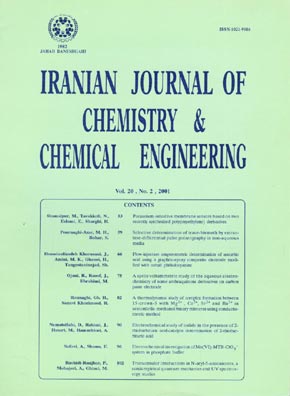فهرست مطالب

Iranian Journal of Chemistry and Chemical Engineering
Volume:20 Issue: 2, Nov-Dec 2001
- 60 صفحه،
- تاریخ انتشار: 1380/01/23
- تعداد عناوین: 8
-
-
Page 53Abstract: Two Poly(oxyethylene) derivatives 1,10-bis (2’-benzoic acid)-1,4,7,10-teradecane (L1) and 1,7-bis (2’-benzoic acid)-1,4,7-trioxaheptan (L2) were used as suitable ionophores for the preparation of potassium-selective PVC-membrane electrodes. The resulting electrodes based on L1 and L2 exhibit linear responses to the activity of K+ ions within the concentration ranges of 3.1´10-5 - 2.7´10-2 M and 2.0´10-5 – 7.3´10-2 M with the slopes of 61.8 and 62.6 mV per decade, respectively. The electrodes show relatively fast response times of 25-30 s and can be used for at least 3 months without any considerable divergence in potential. The working pH range of the electrodes is 3-11. The selectivity coefficients of the electrodes for potential interfering cations including alkali, alkaline earth and transition metal ions are reported.
-
Page 59The voltammetric characteristics of bismuth(III)-oxinate in chloroform at the mercury electrode are investigated and a quasi-reversible behavior for Bi(III) oxinate reduction was confirmed. Preceded by the extraction of Bi(III) oxinate in chloroform, differential pulse polarogrphy was developed in the extracts for the determination of trace-bismuth. The linear range of the calibration graph and the detection limit were 10-6 - 5 ´ 10-5 M and 4.7 ´ 10-7 M of Bi(III), respectively. The suitability and accuracy of the proposed method for the determination of trace-bismuth was established by the analysis of a metallic aluminum sample.
-
Page 66A flow injection method is reported for the determination of ascorbic acid based on amperometric detection, using a cobalt(II) phthalocyanine (CoPc) modified graphite-epoxy electrode. The amperometric response was evaluated with regard to pH, ionic strength of the electrolyte, flow rate of the carrier solution, injected sample volume and conditioning time of the electrode. The limit of detection was 0.013 mM (50mL injected), and the calibration plot was linear in the ranges of 0.025 – 1.0 mM (correlation coefficient, r = 0.9989, n=6) and 1.0 – 10 mM (r = 0.9997, n=5). The relative standard deviation for the measurement of ascorbic acid at several concentrations was 1%. The modified electrode was found to retain its full response in flowing streams for several days of operating time. The results of ascorbic acid quantification in fruit juices and vitamin tablets are reported.
-
Page 82The complexation reactions between Mg2+, Ca2+, Sr2+ and Ba2+ metal cations with 15-Crown-5 (15C5) were studied in acetonitrile (AN) - methanol (MeOH) binary mixtures at different temperatures using conductometric method. 15C5 forms 1:1 complexes with Mg2+, Ca2+ and Sr2+ cations in solutions. The Ba2+ cation forms a 2:1 complex (ratio of ligand to cation) in solutions. A linear behavior was observed for variation of logKf of 15C5-Ca2+ and 15C5-Sr2+ complexes vs the composition of AN-MeOH binary systems, but a non-linear behavior was observed in the case of 15C5-Mg2+ complex in these binary mixtures. The selectivity of 15C5 for Mg2+, Ca2+ and Sr2+ cations is sensitive to solvent composition and in some cases and in certain compositions of the mixed solvent systems,the selectivity order is changed. The values of thermodynamic parameters (DH0c, DS0c) for formation of 15C5-Mg2+, 15C5-Ca2+ and 15C5-Sr2+ complexes were obtained from temperature dependence of stability constants and the results show that the thermodynamics of complexation reactions is affected by the nature and composition of the mixed solvents.
-
Page 90Electrochemical oxidation of iodide has been studied in the presence of 2-thiobarbituric acid using cyclic voltammetry and controlled-potential coulometry. The results indicate that, the resulting iodine takes part in halogenation reaction with 2-thiobarbituric acid. In addition, the present data are indication of the suitability of iodide as quasi mediator for determination of 2-thiobarbituric acid in aqueous solutions. The reaction mechanism was investigated and shown that, the quasi-catalytic peak currents had linearity dependent on the 2-thiobarbituric acid concentration. The method allows the determination of 2-thiobarbituric acid in range 4.0 10 - 1.0 10-3 mol/L. The relative standard deviation for 10 determinations of 1.0 10-4 mol/L 2-thiobarbituric acid is 2.2% and the detection limit of the method is 3.9 10 mol/L.
-
Page 96The reduction mechanism of molybdenum-methyl thymol blue (MTB)-chlorate system has been investigated in water on a mercury electrode. As this system is very sensitive for ultra-trace determination of molybdenum, the actual mechanism involved was studied. Electrochemical techniques, including dc tast polarography and cyclic voltammetry were employed. It is shown that, the cathodic wave of molybdenum in the presence of methyl thymol blue and chlorate has an adsorptive catalytic character.
-
Page 102The ability of the present semiempirical quantum mechanics methods are surveyed for reproducing the the transnnular interaction in the bifunctional N-phenyl-5-azocanones. The AM1 method is the best with the order of reliability being AM1, PM3, MNDO and MINDO/3. AM1 calculations were then carried out for quantification of transannular interaction. The n(O) ionization potential has been used for this purpose. A linear correlation is found between the n(O) ionization potential and the Hammett substituent constant (s). The UV spectroscopy was used to study the transannular bond formation in N-aryl-5-azocanone derivatives.


